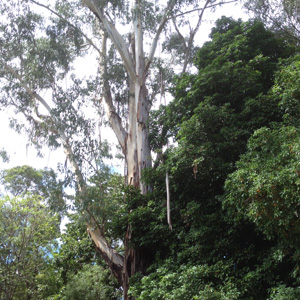Many gardens have established Eucalypts, and as designers, landscapers and horticulturists, we have to be aware of the requirements of these existing trees if we want to have a successful planting under and around them.
I will take three Eucalyptus species as an example of their varied requirements.
Eucalyptus microcorys (Tallowood) is naturally fond in forests near the coast in moderate to fertile soils. It prefers moist, well drained soils. The understorey of Tallowood forests comprises species such as Callicoma serratifolia, Cryptocaria rigida, and Eleocarpus reticulata amongst other. In gardens and parks, the tree’s needs have to be respected and species chosen must follow these needs.
Eucalyptus haemastoma (Scribbly Gum) grows in dry sclerophyll woodland on shallow infertile sandy soil on sandstone. The understorey includes but is not limited to Acacia bynoeana, Grevillea juniperina, Persoonia nutans.
Eucalyptus scoparia (Wallangarra White Gum) in the wild it is restricted to the granite hills and mountain tops of the Wallangarra region of southern Queensland and New South Wales. The understorey has amongst others Kunzea bracteolate, Westringia amabilis, and Grevillea scortechinii.
Plants selection, watering schedules and fertilising should reflect these natural needs. Under E. Microcorys it is possible to plant moisture loving plants both natives and exotics, watering system can be installed and fertilising utilised. For E. Haemastoma the use of low water and nutrient plants are a better choice.
Planting under existing Eucalypts needs not be a trial and error if we understand their natural requirements and plant accordingly.
|
|
About Patrick Regnault
I have worked in the horticultural and landscaping industry for over 35 years in three different countries.I am a member and Registered Horticulturist with the Australian Institute of Horticulture and member of the Housing Industry Association. I am the owner of Interactive Landscapes, a successful structural landscaping and landscape design business. I believe that what gardens and gardening do is to reconnect people with the fundamental elements of nature. A good gardener will try and acquire a profound understanding of the balance of nature and endeavour to do the best to improve the environment in which the garden is situated. At Interactive Landscapes it is a philosophy that we put into practice when designing and creating a garden, no matter the size. Our name reflects this as we understand that gardens are a place of interaction. View all posts by this author » |










